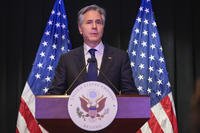The number of civilian workers compared to military service members is the highest in the history of the Pentagon, and that's unsustainable, according to Rep. Ken Calvert of California, the top Republican on a key defense panel.
But the Pentagon begs to differ. Top personnel officials rebutted Calvert during testimony at a House hearing Tuesday and defended the department's 790,000 civilians as key to the defense of the country.
Calvert, the ranking member of the House Appropriations Committee's defense panel, said the Pentagon should reduce the number of civilians by automating a raft of jobs and responsibilities, similar to what's happened in private manufacturing and shipping across the country.
"I don't see how we can afford to maintain the current civilian workforce into the future if we're forced to balance those costs with procurement and research efforts, which are absolutely necessary," he said.
Read Next: More Ink on Heads, Fingers Allowed in Updated Coast Guard Tattoo Policy
The House Appropriations panel was hearing Pentagon testimony on the defense workforce and considering ways the department could use funding to shore up training, recruitment and retention of troops, as well as how to sustain the defense industrial base.
Artificial intelligence could be used to eliminate human civilian jobs in military health care management, intelligence analysis, financial management, and supply chain logistics, Calvert said.
The changes could "save a lot of money -- billions of dollars -- and gradually, not having to fire anybody, but just gradually bringing down the workforce and closing obsolete systems and processes," he said.
Calvert didn’t provide details on his savings estimate, which could potentially come from an annual defense budget of over $700 billion.
Gil Cisneros, the under secretary of defense for personnel and readiness, told Calvert it is "just not proper" to direct cuts to the civilian workforce based on an arbitrary comparison to service members.
"I do not believe we can put a ratio or a number on the amount of civilians that we have," said Cisneros, who served as a Navy officer and lawmaker who sat on the House Armed Services Committee. "The civilian workforce that we have at the Department of Defense is an integral part in the defense of our nation. They play critical roles in the work that we do."
The Department of the Navy is always assessing its workforce to get the right mix, but the metric it's focused on is not the ratio of troops to civilians but whether the services can compete on the battlefield, said Meredith Berger, the senior official performing the duties of Navy under secretary.
"We capitalize Sailors, Marines, Civilians, and it is because of their contribution," Berger said.
The Army, the largest of the service branches, has a 4:1 ratio of soldiers to civilians, and that number has been relatively unchanged for the past five years, said Christopher Lowman, senior official performing the duties of Army under secretary.
The service plans to study how new technologies such as artificial intelligence could affect the civilian workforce. The Air Force is not currently incentivizing civilian retirements but plans to study whether it could be needed in some areas -- it's more focused on recruiting and keeping personnel with high-tech skills, said Gina Ortiz Jones, the under secretary of the Air Force.
Calvert said the Defense Department and military branches are among the largest enterprises in the world and should not be immune to the larger trends in the U.S. of companies streamlining workforces.
No one should argue that civilians are not important, but also no one believes they should outnumber troops, he said.
"But it's growing in that direction," he added. "It seems like there's always a reason not to look, especially at the middle-management structure within the Department of Defense."
-- Travis Tritten can be reached at travis.tritten@military.com. Follow him on Twitter @Travis_Tritten.
Related: Pentagon Mandates COVID-19 Vaccine for Civilian Workers












